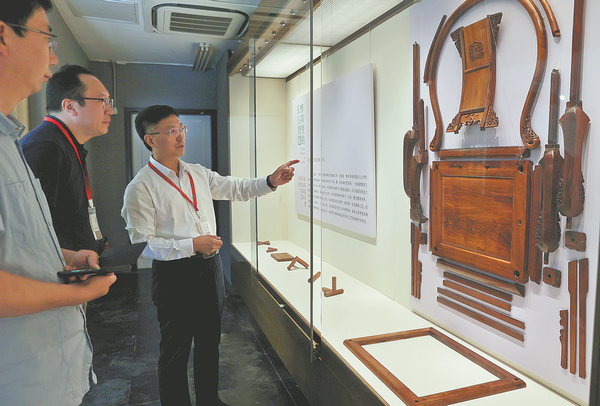

Classical Chinese furniture is viewed by enthusiasts as an example of the harmonious marriage between the simple and the complicated, engineering and aesthetics.
The first glimpse of a chair, desk, cabinet, stool, cosmetic box, bed or any other fine piece of furniture made in the classical style — and often out of precious wood — impresses with its minimalist silhouette. The secret of its graceful form is less visible and lies in its sophisticated sunmao (mortise-and-tenon) system, which allows the various components to be assembled neatly without glue or nails.
Theses seemingly simple forms and their intricate joinery lend grace and serenity to interior spaces, and in a large, culturally diverse country like China, classical furniture styles naturally varied from region to region. Suzhou, a scenic and peaceful city in Jiangsu, a province long known for its wealth, developed its own tradition of classical furniture design over the centuries.
According to Xu Jianping, one of the inheritors of classical furniture design in the city, the Suzhou style presents beauty in the same subtle, delicate way the city does, and embodies the life philosophy of its people to achieve "refinement through careful, meticulous calculations".
The Suzhou native was brought up and trained to be a furniture maker in this cultural atmosphere. Examples of his Suzhou-style furniture are currently on display as part of Oriental Wisdom in Sun Mao, a group exhibition at the Prince Kung's Palace Museum in Beijing.
Running until Sunday, the show demonstrates the way that the complex sunmao technique has been used in making furniture, as well as the variations that developed in different parts of the country. It juxtaposes pieces made by heritage inheritors like Xu in the three major classical styles, which originated in Suzhou, Beijing and Guangzhou, Guangdong province.
Also on display are mortise-and-tenon models of different kinds, as well as the disassembled components of two chairs laid out to give museumgoers a clear view of the inner structure of classical furniture. Vintage pieces representative of the three styles from the museum's collection are also on show.
The Suzhou style flowered during the Ming Dynasty (1368-1644), and once dominated the market in Jiangnan, the southern region along the lower reaches of the Yangtze River. It incorporated input from the intellectual class, who imbued their ideals regarding living spaces and spiritual havens into its design.
Guangzhou style furniture is normally made out of tropical hardwood, and its forms and decorative motifs show the influence of European furniture styles resulting from Guangzhou's history as an international trade port.
It also stands out for its vivid sculptural details. For instance, feet are carved to resemble tiger claws and the wood has decorative shell, jade, enamel and marble elements.
The Beijing style, which is more imposing, incorporates aesthetic and stylistic elements from both Suzhou and Guangzhou.
"While the Suzhou style is light in weight and elegant in outline, furniture in the Beijing style is more exuberant and majestic, as it used to be made for royalty and aristocracy," Xu says.
Sun Dongning the exhibition's curator, says that the furniture has been staged in settings that include Chinese paintings, vases of flowers, incense burners and guqin (a type of zither), to "enhance the experience of the classical philosophies behind living spaces and the cultured lifestyle held by the intellectual class of the past".
Xu says: "Ultimately, people live with their furniture, so the principle of quality furniture is that it should be appropriate to the space."
linqi@chinadaily.com.cn